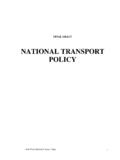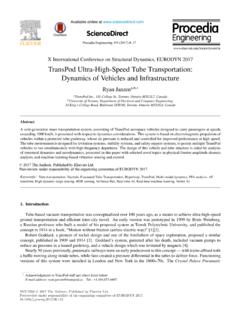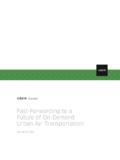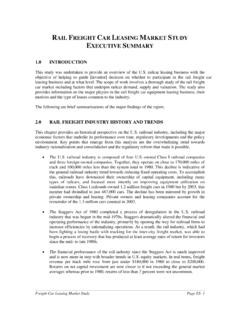Transcription of Vision 2030 Jamaica - Final Draft Transport Sector …
1 Transport . Sector PLAN. 2009 - 2030. Prepared by The Transport Task Force September 2007. Transport Task Force July 2009. Table of Contents Page 1. Introduction 1. Vision 2030 Jamaica National Development Plan 1. Transport and National Development 2. 2. Situational Analysis Jamaica 's Transport Sector 4. Land Transport Sub- Sector Situational Analysis 4. Air Transport Sub- Sector Situational Analysis 12. Maritime Transport Sub- Sector Situational Analysis 16. 3. SWOT Analysis 23. 4. Strategic Vision and Planning Framework 30. Transport Sector Vision 30. Sub- Sector Visions 30. Strategic Vision 31. Strategic Planning Framework 31. Sector Indicators and Targets 35. 5. Implementation, Monitoring & Evaluation Framework for the Transport 36.
2 Sector Implementation Framework 36. Monitoring and Evaluation Framework 38. The Way Forward 40. 6. Action Plan for the Transport Sector 41. 7. Appendices 75. 1. Introduction Vision 2030 Jamaica National Development Plan I n 2006, the Government of Jamaica (GOJ) mandated the Planning Institute of Jamaica (PIOJ) to lead the preparation of a comprehensive long-term National Development Plan (NDP) which will seek to place Jamaica in a position to achieve developed country status by 2030. Development of the Plan began in January 2007 and thirty-one Task Forces (TFs) including the Transport Task Force were established thereafter. The TFs represent sectors and areas critical to the achievement of the national goals and have been charged with responsibility for developing the relevant long-term Sector plans.
3 The Transport Task Force through three sub-committees, viz., land, air and maritime Transport , commenced the plan preparation exercise in April 2007, leading to the completion and submission of a 1st Draft report for the long-term development of the Transport Sector in Jamaica . Following review and stakeholder consultation, and preparation of an action plan for the Sector , the Transport Sector Plan for Vision 2030. Jamaica was completed in 2009. This Sector Plan for Transport is one of the strategic priority areas of the Vision 2030. Jamaica - National Development Plan. It is one of thirty-one Sector plans that form the foundation for Vision 2030 Jamaica a 21-year plan based on a fundamental Vision to make Jamaica the place of choice to raise families, live, work and do business,' and on guiding principles which put the Jamaican people at the centre of the nation's transformation.
4 The preparation of the Plan was supported by a quantitative systems dynamics computer model Threshold 21 (T21) which supports comprehensive, integrated planning that enables the consideration of a broad range of interconnected economic, social and environmental factors. The T21 model is used to project future consequences of different strategies across a wide range of indicators, and enables planners to trace causes of changes in any variable or indicator back to the relevant assumptions and policy choices. This Sector plan was developed using the following processes: Participation of Task Force Members1 through Task Force Meetings2 that were used to solicit ideas and views on Transport issues and challenges facing Jamaica as well as identifying a Vision for Transport in Jamaica , and determining key goals, objectives and strategies for the Sector Sub-committees on land, air and maritime Transport involving Sector stakeholders 1.
5 See Appendix 1 for List of Members of the Transport Task Force 2. See Appendix 2 for Listing of Task Force Meetings 1. Research on international best practices in Transport that could be adopted in the Jamaican context Working group meetings between task force members and the PIOJ. Development of a detailed Action Plan with responsible agencies and time-frames for implementation. This Sector Plan for Transport is structured in the following main chapters as follows: Situational Analysis SWOT Analysis Strategic Vision and Planning Framework Implementation, Monitoring & Evaluation Framework Action Plan Transport and National Development The Transport Sector land, air and maritime - represents a critical component of any country in its impact on national development.
6 One of the most fundamental attributes of the Sector is the ability to move persons, goods and services between spatial locations at the local, regional and international levels. The efficient management of the Sector can provide tremendous economic and social gains to a country through indirect and direct employment as well as induced development which ultimately leads to wealth creation and growth. Studies have revealed that: for every US$ billion investment in highways through the Federal-Aid Programme in the United States of America, approximately 41,000 full time jobs are created for every one million passenger passing through an airport in Europe, 4,000 jobs are created through direct, indirect and catalytic impact on employment in the surrounding community the air Transport industry in 2004 generated a total of 29 million jobs (direct, indirect, and induced) globally in many developed countries, transportation accounts between 6% and 12% of GDP3.
7 It has been stated that an efficient and effective Transport Sector is indispensable to economic progress. Other sectors such as mining, manufacturing, trade, tourism and agriculture which are critical to a nation's growth and development, like many other sectors depend upon transportation. Without adequate infrastructure to facilitate the movement of people and goods, economic and social benefits will be limited. Jamaica Transport system includes: (i) a total of 15,394 km of road network (all categories)4; (ii) an airport infrastructure of two international airports and four domestic 3. Rodrigue, Comtois and Slack (2006). 4. 844 km of arterial roads, 717 km of secondary roads, 3,225 km of tertiary roads, 282 km of urban roads, 10,326 km of parochial roads and 800 bridges on main road.
8 Source: Transport Policy. 2. aerodromes; (iii) a railway network covering approximately 331 km of track as well as six privately owned mining railways lines; and (iv) a maritime Transport infrastructure of fourteen major seaports. During the period 2004-2008, Transport , Storage and Communication (TS&C). contributed on average to Jamaica 's Gross Domestic Product (GDP)5. In 2008, Transport (road, railway, water and air including services allied to Transport ) and storage contributed to total The overall Transport Sector (including land, sea and air Transport ) is the largest consumer of petroleum in the Jamaican economy, accounting for 37% of the total quantity of petroleum consumption in Investment in infrastructure has been shown to have a significant effect on economic growth.
9 The results of the Threshold 21 Jamaica (T21) T21 MODEL. model indicate that improvement in the physical economic SIMULATION. infrastructure (such as roads, air and sea ports, and telecommunications networks) usually has higher payoffs in A model simulation was conducted to quantify the the form of higher rates of economic growth than equivalent effect of shifting public investment in health and education over the time horizon to resources toward 2030. This is because such improvements have a faster infrastructure. The impact on total factor productivity. exercise suggests that a ten percent proportional transfer of Government's The returns to investment in physical infrastructure tend to be discretionary budget in high in countries at Jamaica 's income level, especially favour of infrastructure considering the relative underinvestment in physical raises GDP per capita in infrastructure in recent decades.
10 These higher growth rates 2030 by per cent, eventually increase the size of the economy and the levels of while drawing from General Services to effect funding available for other services such as health and the transfer yields a education over the medium and long term. High-quality per cent gain. infrastructure contributes to social and environmental goals, by improving access to public services, reducing negative environmental impacts and supporting the sustainable use of natural resources. The provision of infrastructure poses special problems in part because of the public interest dimensions of public utilities and the long-term nature of financial commitments. The private Sector may be reluctant to invest in infrastructure, unless supported by a secure and equitable policy environment.







